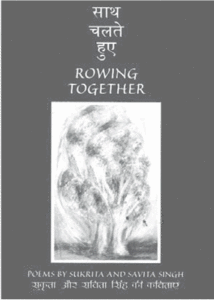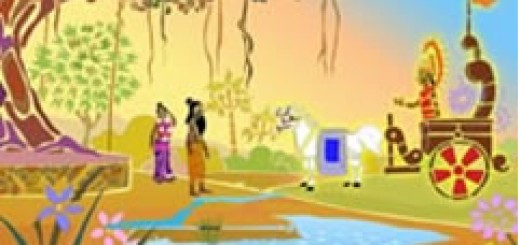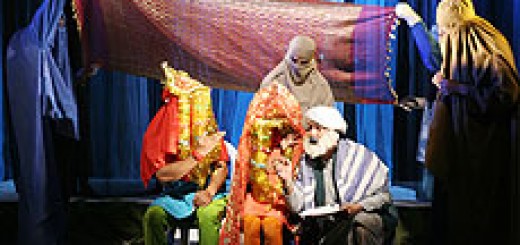Book Mark – Saath Chalte Hué • Rowing Together
Meenakshi F Paul Reviews the Book of Poems which will be read out live by the two poetesses at IIC on April the 28th
Poet to poet translation, infrequent in the past, is gradually increasing as a dynamic collaboration between creative imaginations. Transcreation requires sensitivity, understanding, felicity with words, sensibility and imagination to avoid being wooden and clumsy. Often, writers are averse to their works being translated because the process becomes a mere faithful rendering, rather than catching the essence and flavour of the work.
Therefore, it is a good idea to have poets translate each other’s writings, thus, giving the poems a whole new persona in clothes of different fabrics and hues while preserving the essential grain and spirit of the inspiration. Since 2005, the collaborative “Poet to Poet Translation Project” of Cove Park Resource Centre, British Council Scotland, and Edinburgh:UNESCO City of Literature successfully showcased how mutual transcreations across cultures and languages may be rewarding, both for the poets and for the readers. In India, Sukrita and Savita Singh have brought together Saath Chalte Hué • Rowing Together with reciprocal transcreation of poems into Hindi and English. This commendable creative cooperation between the two poets reveals how creative egos are channelled to a rich partnership; as both claim each other’s poetry for themselves, imbuing them with their own colours through the prisms of their experience and imagination. The title evokes the words of Sri Chinmoy: “O my friend, / Let us claim each other first. / then let us walk together / Towards our destined goals.” This kinship is apparent throughout the ambulations of the poets alongside each other.
The rendering of Saath Chalte Hué into Rowing Together, or vice-versa, is an apt pointer to the travellers who veer away from the everyday and the obvious to burrow deep into the undiscovered, the unexplored. ‘Rowing’ suggests the effort made in concert, the delight of the voyage and the joy of arrival. It also gives weight to the importance of mutual trust and equal energy and commitment in the enterprise.
The poems are divided thematically into eight sections with poems by Sukrita and Singh in the original juxtaposed with the transcreated versions. The name of the ‘original’ writer is given at the bottom of the page, the translation alongside is by the poet rowing with her. Both blend seamlessly together largely because of the empathy between the poets, which helps them encompass not only the words but also the silences of the poems.
The first section: Hona • Being has eight poems, five by Sukrita and three by Singh. The poems revolve round the desire to be and the trepidation of the unknown. “Jab Saanp Ashray ke Liye Aaye • When the Snakes Came for Shelter” by Sukrita is a powerful and intense poem, which uses the symbol of the snakes to foreground the struggle for freedom inZimbabwe and the continued peacetime battle against treachery and oppression of women everywhere. The translation into Hindi, for the most part, matches the English and is able to catch the sinister undertone admirably: “Her long dark limbs / Glistened /And entwined in the coiling / snakes/ As darkness slithered / Towards the break of dawn / Haunting Salvador Dali”—“Uske chharharey kaley ang / Chamakte thhé / gunthhe hué kundali marte / saanpon se / Jab pahuncha andhera rengta hua / Bhor ke ujale ki taraf / Salvador Dali ko haunt karta hua”. Singh’s “Prem ke Baare Mein • Of Love” captures the lost promise of Sylvia Plath’s life and the poetry she could have created. The pathos of her death in lonesomeness and despair questions the man-woman relationship and the haloed idea of love.
The second theme: Srijana • Creating has five poems by Singh and four by Sukrita. Singh’s poems explore the agonizing process of writing, of translating the imagined on paper: “For some times now / A poem lay within me / I told her wait as yet […] / Why is life for such as us / so troubled / So difficult” (“Hum Jaison ka Jivan • Life of Such as Us”). In “Gallery Mein • In the Gallery” Sukrita dextrously interplays images of steel, human flesh and trees to underscore the paradoxes of livings just like the tree trunks as pieces of art can be “A withering or a blossoming”.
Section three entitled: Anyata • Othering consists of four poems by Singh and three by Sukrita. Singh uses concrete imagery in “Sara ka Sundar Badan • Sarah’s Beautiful Body”, “Allen ka Dost • Allen’s Friend”, and “Ruth ka Sapna • Ruth’s Dream” to evoke alienation and emptiness. Singh employs the snow motif in many poems to underline the difficult and the sad but, paradoxically, desired experience by the poet. Sukrita’s poems are musings on the life of the elderly in a materialistic and individualistic society (“America mein Budhate Hué • Ageing inAmerica”) and of the homeless but spirited poor in the workers’ world (“Hum Beghar • We the Homeless”) The poems are vignettes of the close ‘other’ within us who we are afraid to encounter. “Sunami ke Snapshots • Tsunami Snapshots” brings out the fundamental unease of the poet with the random draw of hand by natureprovidence. The helplessness of a sensitive mind while grappling with the tsunamic ironies and paradoxes of life is feelingly articulated.
The fourth theme: Nirkhana • Seeing contains four poems each by the two poets. Sukrita delves into the ineffable bond between mothers and daughters. The continuity of ties in womanhood through the generations is represented by the unsevered umbilical cord of the heart. The pain of birthing and separation is placed hopefully and contrapuntally to the joy of oneness: “I am, / I know now, / my mother, / as you / are yours” (“Itihas • History”). Singh’s poems vivify the objectification and suppression of woman as well as her joys and strivings. “Jaise Ek Stree Janati Hai • The Way a Woman Knows” brings out these themes in an interesting metaphor: “Who can get to know the body/ As a woman would / Who can know which boat she can make with it / Which river she can cross.”
Section five: Palna • Nurturing puts together three poems each by Singh and Sukrita. Singh evokes nature imagery in her attempts to “make a nest” of belonging and identification in the face of disjointedness: “Once when I told them my name / I too am a tree I explained / Every tree refused to recognize me”. Sukrita, once again, bridges the past and the present, the self and the other with resonant simplicity. An example of her layered verse is apparent in (“Ant se Prarambh • End from the Beginning”, in which the primordial forest with an unfathomable well is seen “inviting lovers / to come down the spiral steps / carved on his chest, / to reach the womb of time / and touch the / beginnings of history”).
The sixth theme: Chintana • Reflecting has one poem by Singh and four by Sukrita. The mood in this section is contemplative and gentle with nature imagery and the theme of bonding foregrounded once more. In this section, despite the loss there is an undercurrent of hope as is made clear in these words: “A suspended story, a void / That was filled / By you and you, / My children” (“Chetana Pravah • Stream of Consciousness”). The seventh section: Pira • Suffering consists of three poems by Sukrita and two by Singh. The section begins with an extremely penetrating “Akhet • The Hunt” on the Gujarat riots in the larger perspective of the brutal, mindless violence in the cycle of creation and destruction, of karma and retribution. It resurrects the: “Ghosts of unborn children / not resting till / they enter bodies of / their killers and of / those who raped their mothers”. All the poems in this section make for compelling reading in these times of escalating intolerance and schisms in society. The pain and the mourning of women seek sanity in the encompassing reality where Singh laments: “So many wounds on the body / Many more on the mind / Even more on the map of the country” (“Desh ke Manchitra Par • On the Map of the Country”).
The final section, entitled: Basera • Dwelling, houses three poems by Sukrita and five by Singh. “Bevafa Yaadein • Unloyal Memory” uses crisp imagery of a locked-up house to capture the nebulous eroding of remembrances with every re-memorying. “Jo Narcissus ke Saath Dub Gaya • That which Drowned with Narcissus” is a yearning for beauty that is unalloyed, perfect. “Sach Kahin Chala Gaya • Truth has Wandered Away” is a longing for freedom and truth when “We are left only with lies now / That can take us far / […] Freedom is merely a suspect word / Power is the real issue.”
Saath Chalte Hué • Rowing Together is a navigation of the broad stream and the backwaters in camaraderie and team spirit. The distinct personalities of the poets complement each other even as they bring their own quintessence to the venture. The reader is taken into the boat as a partner who maps the passing landscape and the stopovers as the poets take up the oars. In midstream the currents of what is meant by ‘original’ work, interlanguage exchanges, and translation as creation are met and grappled with. The baggage of the supremacy of one language is tossed overboard for a lighter, smoother sailing. Both the oars, one of Hindi and one of English, are grasped with equal fervour and command. The craft of poetic creation and transcreation is finely balanced in the rhythm of the rowers. Thus, the deep clear waters as well as the tumultuous rapids of ideas, images and words are negotiated in tandem by both the poet-translators with fluid, clean, and assured strokes. There are, naturally, a few instances when a piece appears more forceful and flowing in one language than the other. For instance, in “When the Snakes Came for Shelter” these lines of underlying portent: “She smelt no danger / Nor did they, / there’d be no holding the venom / if they did”) are somewhat watered down in the Hindi rendering. However, such log jams are very small and occasional. They do not take a bit away from the captivating world that the poets take us to sight downstream. Many poems, such as “Hum Beghar • We the Homeless” obscure the barrier of the original with the transcreated. Each version is complete in itself. Both are ‘original’ even as one is a flawless transcreation of the other. In Saath Chalte Hué • Rowing Together the “signposts of having co-travelled” are clear and vivid as the two poet-translators inhabit each other’s imaginative worlds in words and in silences. Medha Singh’s sketches are beautiful icons of the themes and add to the experience of reading the verse. It is hoped that this excellent volume will fuel more such collaborative literary expeditions and discoveries.
Meenakshi F Paul is Associate Professor, HPU Centre for Evening Studies Shimla-171001 (courtesy www.confluence.org.uk)
Saath Chalte Hué • Rowing Together
by Sukrita Paul Kumar and Savita Singh.
New Delhi: Rajkamal, 2008, 179 pp.,
ISBN: 978-81-267-1465-0, Rs 250











